8 Sudoku strategies for beginners explained

Sudoku can look deceptively easy to solve due to its simple and straightforward rules. Nevertheless, these puzzles are designed to always be challenging, regardless of the level. New players are thus bound to encounter difficulties filling the grid and should expect to do so. Fortunately, there are some Sudoku strategies for beginners that can help them find their way easily and get used to the mechanics of the game.
1. Crosshatching
Crosshatching is the first strategy any Sudoku player can apply when facing a Sudoku grid.
The player should focus on each square of 3x3 at a time and detect the missing numbers in them. The next step will be to take every digit individually and cross the information of each row and column to the other squares connected to the one being analyzed.
Example
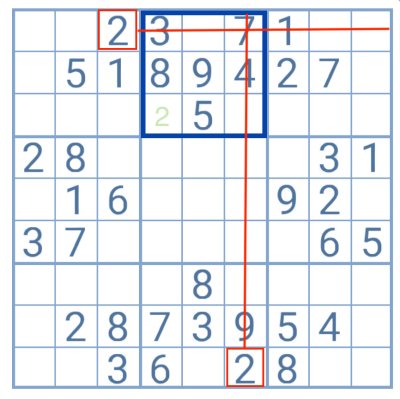
In the highlighted square, there are three empty spots to be filled with the missing numbers 1, 2, and 6.
Two rows connected to the main square contain the number 1. Crossing this information will still leave two possible places open for this digit. Similarly, the 6 is present in one column connected to the square, but once again it will only eliminate one possibility, leaving this digit as a candidate for two cells.
However, testing for number 2 reveals only one possible solution for this digit. The player can then safely fill the only blank space left with it.
Note: Although it cannot be considered part of Sudoku strategies for beginners, players should always pay careful attention to the grid’s evolution every time a new number is placed.
In the example above, the cell that number 2 took was one of the possibilities also for number 1. Thus, now there is only one solution for this digit too. And by placing number 1, only one blank remains, the one to be occupied by number 6. Number 2 unlocked the solution for the highlighted square.
2. Counting
Counting is a useful strategy when the player finds a row or column partially filled, with only 2 or 3 missing blank cells.
As there cannot be any digits repeated per row or column, the player only has to count the allocated numbers to find the missing ones. This will allow the player to set candidates for each blank cell. The next step will be to cross the information of rows, columns, and the group the cell is inserted in to try to find the solution.
Example
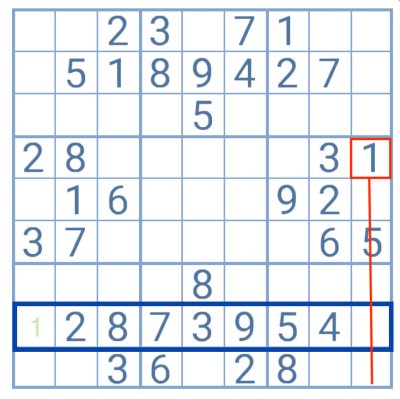
Numbers 1 and 6 are the only ones missing in the highlighted row, so the player can safely note them down as candidates for the two remaining blank cells.
However, crossing the information of the columns that connect to each blank cell reveals that number 1 only has one possible placement in the highlighted row. The only place left will then be occupied by number 6.
3. Naked singles
Naked singles have a high incidence in easy levels, which makes them one of the most useful Sudoku strategies for beginners to learn.
To apply it, the player should note down every candidate for each individual cell. The easiest way is to focus on each square of 3x3 at a time. If after taking note of every digit the player finds one cell with one single candidate (or a naked single), that will be the solution, regardless of whether that number is also a candidate in other cells within that group, row, or column.
Example

The grid above is an example of a work in progress in Sudoku. There are still many uncertainties and many blank spaces.
Number 2 has two possible solutions in the highlighted square and it is still impossible to determine its position by solely crossing the information of rows and columns. However, when the player filled in the candidates for each cell in that group, number 2 remained the single candidate for one. The player has thus found a naked single and can safely place number two.
4. Hidden singles
While naked singles refer to a cell with a single candidate, a hidden single occurs when one digit has only one possible position, even if it's mixed with other candidates in that cell. In this case, the player can safely remove the remaining candidates and keep the solution.
Example

In this example, number 7 only has one possible solution in the group in which it is inserted. That will thus be its final position. It is a hidden single because numbers 5 and 9 are also candidates for its cell.
5. Naked pairs
Pairs are a set of Sudoku strategies for beginners that help to reduce the number of candidates in cells, rather than finding a solution.
Naked pairs are simple and easy to spot. They occur when two cells in one row or column have solely two candidates and these are identical. The player cannot yet tell the final position for each digit of the pair, but they can already ascertain their overall position in the grid. Thus, those digits can be safely eliminated as candidates for other cells in the same row/column.
Example
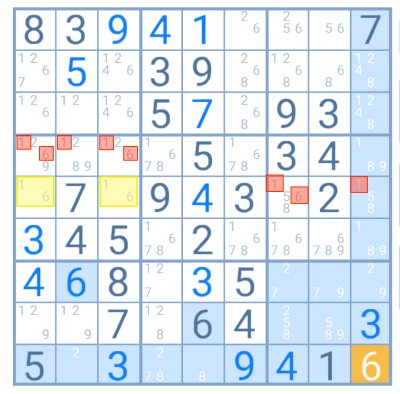
Highlighted in yellow is an example of a naked pair. In this case, the player has two identical candidates alone in two different cells within the same row, which means this will be the final position of 1 and 6, even though it is not possible to determine the solution yet. However, knowing this, the player can already remove these two digits as possible candidates for cells within the same row and within the same group.
6. Hidden Pairs
Hidden pairs take place in groups of 3x3. They occur when two cells have a pair of identical candidates, and these digits are not possible in any other place within that group.
Therefore, those will be their final position, even though the player has yet to find the solution. The remaining candidates can be deleted from those cells. They are hidden because they are often mixed with several other candidates, making it harder to find the pairs.
Example
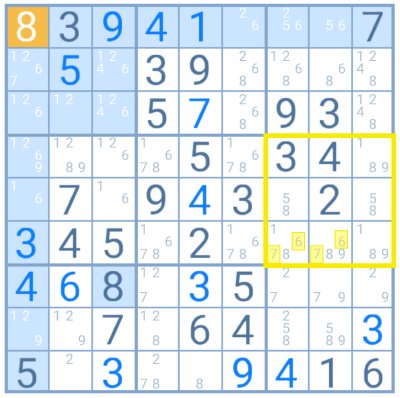
In the group highlighted, the numbers 6 and 7 are candidates in only two cells, and they are paired up. It follows that their solution will be found in these two spaces and, therefore, the remaining candidates can be eliminated (7, 8, and 9).
Because they are lined up in the same row, the result will be a naked pair. However, hidden pairs do not necessarily give place to naked pairs, as they can be positioned anywhere within the group.
7. Naked triples
Naked triples are sets of identical pairs (a/b-a/b) or identical triples (a/b/c-a/b/c) that occur in three cells in one row or column. These three cells cannot contain more candidates.
The player can then assume the final answer will lie in those cells and eliminate those digits as candidates for any other cell in the same row or column.
Example
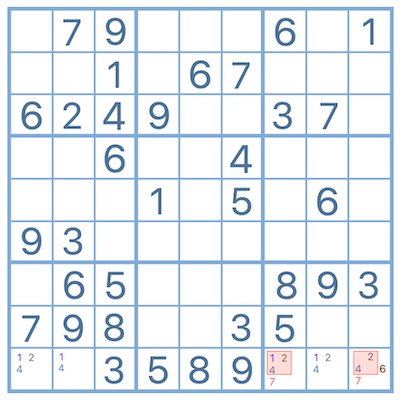
In this example, the player has a row with three cells containing three identical numbers (1/2/4). There are no other possible numbers for those cells. This means that placing a digit in one of them will directly affect the remaining two and force their solution.
For example, if the player places the 1 or the 4 in the first cell of the row, then the second cell becomes a naked single, which in turn will leave the third cell with the number 2 also as a naked single.
If the player places the 2 as the solution for the first cell, then the two other cells will turn into naked pairs (1-4).
Therefore, regardless of the situation, the digits in this set (1/2/4) can be eliminated as possibilities for the other cells in that row.
8. Locked Triple
Naked triples and locked triples are very similar Sudoku strategies for beginners. The only difference between them is that, while the first occurs in a row or column, the latter takes place within a group.
The assumption is the same in both cases. If the player finds three cells with 2 or 3 identical candidates alone, those digits can be safely removed as candidates for other cells within that group.
Example
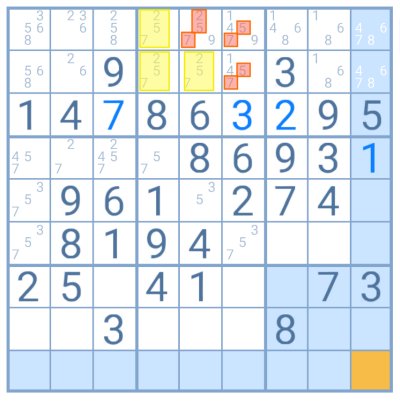
Highlighted in yellow are three cells with three identical candidates (2/5/7). As per the strategy of locked triples, those digits can be deleted as candidates for other cells within that group (highlighted in red).
These Sudoku strategies for beginners are a great tool for any new player encountering these challenges for the first time. The more challenges the player faces, the more these strategies will become embedded in their brain and they will be using them without even realizing it. They are the first building block to becoming a Sudoku expert.












